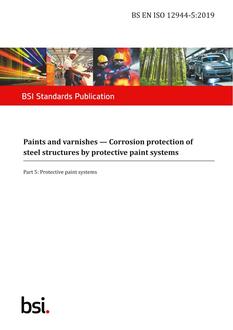ISO 1461:2009 specifies the general properties of coatings and test methods for coatings applied by dipping fabricated iron and steel articles (including certain castings) in a zinc melt (containing not more than 2% of other metals).
- The basic specification for hot dip galvanized coatings on iron and steel articles is defined by a single standard, EN ISO 1461 ‘Hot dip galvanized coatings on iron and steel articles – specifications and test methods’. However, there are some exceptions to this standard (see thicker coatings below).
- ISO 1461 EN ISO 1461 Standard Galvanizing Specifications ISO 1461 was prepared by Technical Committee ISO/TC 107, Metallic and other inorganic coatings, Subcommittee SC 4, Hot dip coatings (galvanized, etc.). This third edition cancels and replaces the second edition ( ISO 1461:1999 ), which has been technically revised.
- Din en iso 14713-1: 2010: zinc coatings - guidelines and recommendations for the protection against corrosion of iron and steel in structures - part 1: general principles of design and corrosion resistance (iso 14713-1:2017) din en iso 2081 e: 2009.
- International Standards Organization ISO 1461, Hot Dip Galvanized Coatings on Fabricated Iron and Steel Articles Specifications and Test Methods, is a general galvanizing specification. This specification is essentially equivalent to the American Society of Testing and Materials. (ASTM) A123 and A153.
To ensure the best quality and technical back-up service, it should be stated that the work be 'processed by a member of Galvanizers Association'.
The basic specification for hot dip galvanized coatings on iron and steel articles is defined by a single standard, EN ISO 1461 ‘Hot dip galvanized coatings on iron and steel articles – specifications and test methods’. However, there are some exceptions to this standard (see thicker coatings below).
When hot dip galvanizing is specified, the surface of the steel is completely covered with a uniform coating whose thickness is determined principally by the thickness of the steel being galvanized (see below).
This is an important advantage of the galvanizing process; a standard coating thickness is applied almost automatically. The actual thickness of galvanized coating achieved varies with steel section size, surface profile and surface composition. Actual coating weights are often much more than the minimum specified in the standard. As coating life expectancy figures quoted are based on the minimum coating thickness they are therefore usually very conservative.
Relationship between steel thickness and surface area/tonne
Guidance on the design and performance of hot dip galvanizing is contained in EN ISO 14713 Part 1 and 2.
EN ISO 1461: coating minimum masses/thickness on articles that are not centrifuged
EN ISO 1461: coating minimum masses/ thickness on articles that are centrifuged
UK National Building Specification (NBS)
There are many references to specifying hot dip galvanizing throughout the National Building Specification (NBS) system, the main location being G10 – Structural steel framing. General guidance on corrosion protection is also given.
Din En Iso 1461 Pdf Download
In the unlikely event of being unable to identify the correct clause for a particular galvanizing application, please contact Galvanizers Association for specific advice.
The galvanizer acts as a specialist subcontractor to a steel fabricator and, as such, his contractual relationship is with the fabricator, not with the ultimate user. It is important, therefore, that the user’s requirements for galvanizing are made clear to the fabricator and that all communications concerning galvanizing are channelled through the fabricator.
Thicker coatings

Thicker coatings than those set out in EN ISO 1461 can give additional protection for use in particularly aggressive environments and can be specified in conjunction with EN ISO 1461. It should however, be emphasised that for most applications, thicker coatings are rarely necessary.
Grit blasting prior to galvanizing is usually the most appropriate method and a requirement for a nominal coating thickness of 1000 g/m² (140 µm) has been successfully specified for steel of 6 mm section thickness. For structural steelwork, it is advisable to ascertain whether thicker coatings could be achieved through their greater section thickness and without grit blasting.
Achieving thicker coatings through specification of a reactive steel is normally only appropriate for specific applications.
Specification of thicker coatings must only be made following consultation with the galvanizer concerning viability and the means by which they will be achieved.
How to Specify Hot Dip Galvanized Steel
Galvanizing to Standard BS EN ISO 1461
ISO 1461:2009,Hot dip galvanized coatings on fabricated iron and steel articles — Specifications and test methods.
ISO 1461:2009 is available for free download and is shared by rose from the United States. This PDF document can be used only for your study. It is strictly prohibited to use it in business. Please support the standard of official publication.
ISO 1461:2009 specifies the general properties of coatings and test methods for coatings applied by dipping fabricated iron and steel articles (including certain castings) in a zinc melt (containing not more than 2 % of other metals).
This International Standard sets out requirements for the contents of the zinc melt used to apply a galvanized coating to articles (see 4.2) .The chemical composition and the surface condition (finish and roughness) of the basis metal, the mass of the parts and the galvanizing conditions may affect the appearance, thickness,texture and physical/mechanical properties of the coating. This International Standard does not define any requirements regarding these points. Guidance on these parameters can be found in ISO 14713-2.